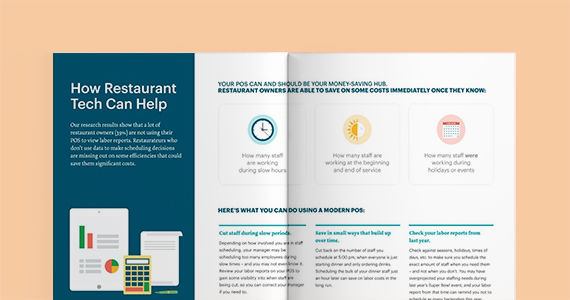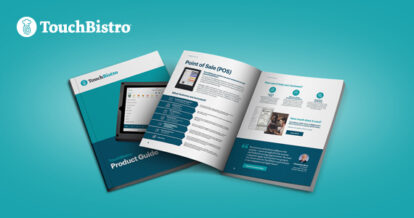If a restaurant’s operating costs were a pie, the cost of labor would be the biggest slice.
And that slice is only getting bigger because restaurant labor costs are on the rise.
Part of the reason for the increase is higher minimum wage rates. Though the federal minimum wage in the U.S. has not increased since 2019, 27 states and the District of Columbia have all increased their minimum wages since 2014. Some states have also adjusted their tipped minimum wage.
But minimum wage hikes only tell half the story when it comes to increasing labor costs. Restaurants must also contend with a labor shortage, shifting worker demographics, and industry saturation. In other words, it’s a perfect storm.
With greater pressure on restaurateurs, this means:
- You may need to change the way you schedule staff.
- You may need to try new things to keep staff happy.
- You may need to re-evaluate your current processes for the sake of survival.
Though this may sound like it will take some work, changing your business strategy can keep your labor cost percentage in check and make your restaurant more resilient in the long run. To help you stay in the game and keep profits healthy, we’ll highlight six ways to deal with the increased cost of labor.

Find out which states are facing hikes and how restaurants manage higher labor costs.
1. Review Seasonal Hiring
Do you hire more staff over the summer and during the holiday season? It may be time to cut back and ask your regular staff to take on more shifts during peak times of the year. Steven Mastoras, owner of Whistler’s Grille & The McNeil Room in Toronto, “expects to have to shed as many as 10 staff, mostly young seasonal workers brought on for the summer, by 2019.”
You may not need to cut your entire seasonal staff, but eliminating two or three positions can save you significant labor costs and prevent you from needing to raise prices. And who knows, you may even find out you’ve been taking on too many seasonal hires to begin with. How do you find out? Well…
2. Analyze Your Labor Reports
You may be able to knock off some low-hanging fruit with the help of a restaurant labor management software and reviewing your labor reports and analytics. Restaurateurs who don’t use data to make scheduling decisions are missing out on some efficiencies that could save them significant costs.
Check your labor reports regularly against seasons, holidays, times of days, etc. to make sure you schedule the exact amount of staff when you need them – and not when you don’t. You may have overprojected your staffing needs during last year’s Superbowl event, and your labor report from that time can remind you not to schedule as many bartenders this year. You can also save in smaller ways that will build up over time, such as cutting back on the number of staff you schedule at 5:00pm, when everyone is just starting dinner and only ordering drinks. Scheduling the bulk of your dinner staff just an hour later can save on labor costs in the long run.
3. Focus on Retention
We’ve said it before and we’ll say it again; retaining your staff is one of the best long-term strategies for minimizing labor costs. It may seem counterintuitive, but investing in your current staff can save on the more significant costs of training new staff – better to invest less in developing your star staff’s skills and recognizing them when they do great work.
The restaurant industry is notorious for its high turnover rates, but that doesn’t mean you can’t buck the trend with a great staff retention strategy. Use staff reports to find out who’s selling the most or bringing in the most tips, and reward them with public recognition, a free meal, some cocktails, or – even better – paid time off. When your high performers are publicly recognized, you’ll kill two birds with one stone by making your best staff feel great while letting your other staff know how they can succeed.
4. Crosstraining and Skill Development
Retaining great employees also means investing in training that builds on skills that already exist within your staff. Crosstraining is one of the most efficient ways to ensure your staff are able to take on multiple types of shifts and feel like they’re advancing their skills.
Training your dishwasher to take on other kitchen tasks can lighten the load when your cooks are in the weeds and there aren’t as many dishes to do. Training your hostess to take on a serving shift when someone gets sick can help prevent many last-minute disasters. You’ll also find that when you crosstrain staff, they develop better relationships with more employees, which can improve your staff morale as a whole.
5. Online Ordering
The automation age isn’t coming – it’s already here. Online ordering is helping full service and quick service restaurants alike save on front of house labor costs by complementing in-person customer service with technology.
With online ordering, customers can explore your interactive online menu, then place an order for right now directly on your restaurant’s website. All of these orders then flow directly into your TouchBistro POS in real-time, with notifications for every new order that’s been placed so you can make money without your front of house staff needing to answer a phone or even lift a finger.
Restaurants that have adopted the technology are seeing a significant increase in average guest check size by prompting for priced modifiers, increasing order volume, and highlighting high-margin items and sides with beautiful pictures.
But be careful: online ordering can actually create more demand on your kitchen staff and increase your cost of labor in a different way. Many restaurateurs assume that online ordering will free up their front of house staff from taking orders. But what these restaurant owners forget to consider is that adding online ordering can trigger an increase in ordering throughput, which can put more stress on your back-of-house staff to keep up. So make sure to test your capacity after adding online ordering so that you know how you’ll need to staff up to remain efficient.
6. Raise Prices
Finally, you may just need to raise prices on some of your menu items to make up for your increased labor costs. As much as you may be afraid to make your regular customers angry, they may not mind paying a dollar or two more for their favorite dish.
When you’re raising prices, make sure to do so consciously: only raise prices on items that are selling well, not on items that are struggling. You may also want to take the opportunity to change up your menu entirely, and that way it doesn’t look like you’ve raised prices – it just looks like you’ve added some new items.

Find out which states are facing hikes and how restaurants manage higher labor costs.
While every industry has faced change, history has been kindest to those who have adapted. Change doesn’t need to be a bad thing – you may in fact find out that you can discover better ways of operating when you’ve been forced to innovate and reduce your cost of labor. So put on your thinking cap and dig into some data. Be creative. Rising wages can be an opportunity to make your team stronger.
Download your free employee handbook template
Sign up for our free weekly TouchBistro Newsletter







